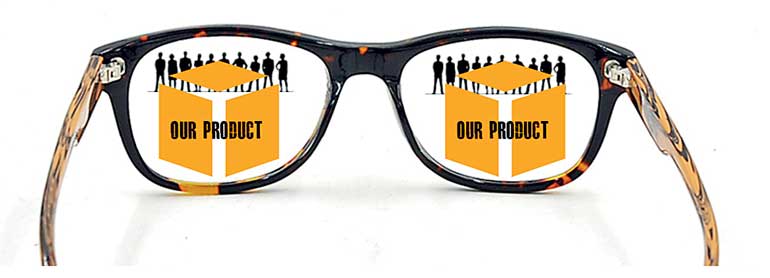Sunday Nov 23, 2025
Sunday Nov 23, 2025
Tuesday, 18 January 2022 01:02 - - {{hitsCtrl.values.hits}}

Companies are always concerned about their product and do many modifications without focusing on the actual “solution” that the customer is looking for. Because of that you always have this so-called short-sightedness
 In the discipline of marketing, we always talk about ‘marketing myopia’ and the implications of this concept. This is the area that has been extensively elaborated in many forums, seminars, and in the field of research. The practical and theoretical value of this concept of Theodore Levitt is really essential for the proper application of customer-oriented marketing. If you are a marketer Levitt’s ‘marketing myopia’ is an essential requirement for your marketing vocabulary.
In the discipline of marketing, we always talk about ‘marketing myopia’ and the implications of this concept. This is the area that has been extensively elaborated in many forums, seminars, and in the field of research. The practical and theoretical value of this concept of Theodore Levitt is really essential for the proper application of customer-oriented marketing. If you are a marketer Levitt’s ‘marketing myopia’ is an essential requirement for your marketing vocabulary.
What is marketing myopia?
The word of myopia is always dealing with short-sightedness. If you google this concept, it always aligns with vision condition and it says that “a common vision condition in which you can see objects near to you clearly, but objects farther away are blurry”. This can be seen as the same in the definition of Theodore Levitt in which he argued that the companies are more concentrated on producing goods or services and not willing to spend enough time understanding what customers want or need.
The following can be considered as the famous railroad example by Levitt: “The railroad did not stop growing because the need for passenger and freight transportation declined. That grew. The railroads are in trouble today not because that need was filled by others (car, trucks, airplanes and even telephones) but because it was not filled by the railroad themselves. They let others take customers away from them because they assumed themselves to be in the railroad business rather than in the transportation business. The reason they defined their business incorrectly was that they were railroad-oriented instead of transportation-oriented; they were product-oriented rather than customer-oriented.” (Levitt, 1960, p. 45).
This can be seen as one of the problems we can witness in many businesses. Companies are always concerned about their product and do many modifications without focusing on the actual “solution” that the customer is looking for. Because of that you always have this so-called short-sightedness. The solution for you is to focus more on customer orientation which always needs to give them answers. This can be seen as one of the lessons Levitt used to teach his students, “People don’t want a quarter-inch drill. They want a quarter-inch hole!”
Myopic marketing myopia
This concept has been heavily discussed for the last six decades. Nevertheless, now the world has started to confer more on “Gross Domestic Happiness” (GDH) rather than “Gross Domestic Product” (GDP). Most business leaders and researchers extensively talk about this “Happiness” continuously. In one of the Q&A on Facebook, Mark Zuckerberg elaborated more on happiness. As per Zuckerberg: “To me, happiness is doing something meaningful that helps people and that I believe in with people I love. I think lots of people confuse happiness with fun. I don’t believe it is possible to have fun every day. But I do believe it is possible to do something meaningful that helps people every day.
Refer following remarks of Steve Jobs: “I hope you realise, when you have mates, buddies and old friends, brothers and sisters, who you chat with, laugh with, talk with, have sing songs with, talk about north-south-east-west or heaven and earth, .... That is true happiness!!”
We need to understand the world has changed drastically and this has been further triggered by the COVID-19 pandemic as well. People are more willing to see the difference between “satisfaction” and “happiness” and we can see there is a paradigm shift of minds of communities.
Hence rather than customer orientation, we need to focus more on “happiness” and marketers need to be more human-centric than customer-centric. This can be a challenge in the next decades. In this scenario, we should focus more on Marketing 3.0 as it dictates that “instead of treating people as consumers, marketers must approach them as whole human beings with minds, hearts and spirit”. Experts in the subject of marketing should be more vigilant on “Indigenous marketing” as “happiness” can be personalised within communities by bring them happier (rather than the satisfaction).
And also, as per Smith and Gentile (2010) “marketers have taken Levitt’s advice to an extreme, creating a new kind of short-sightedness, marked by a single-minded focus on the customer, a narrow definition of the customer, and a failure to address the multiple stakeholders who have arisen out of the “changed societal context of business”. So, they argued having a “broader perspective” which should take into consideration. Even we can think of the Triple Bottom Line (TBL) approach in this perspective as well (TBL goes beyond profit and deals with two additional sustainable drivers such as profit, people, and the planet). Because you need to always focus on sustainability.
I think we need to understand Levitt’s Marketing Myopia as one of the important concepts with practical value which yet needs to be revisited with some more considerations including happiness, humane with sustainability.
Conclusion
There is a requirement to have more adaptation/s for whatever the disciplines. Future it is all about the multi-disciplinary nature of learning with focusing more on “humane” being important. It is clear that we need to be more focused on the “happiness” of the customer and not the “satisfaction” of the customer. This is the era in which we can see people on this earth willing to move away from the materialistic society. Sometimes Maslow’s hierarchy of needs can be again revisited by giving a novel definition for his “self-actualisation need” to align with “happiness”.
(The writer is a Professor in Management Studies, Faculty of Management, at the Open University of Sri Lanka. You can reach Professor Abeysekera at [email protected].)